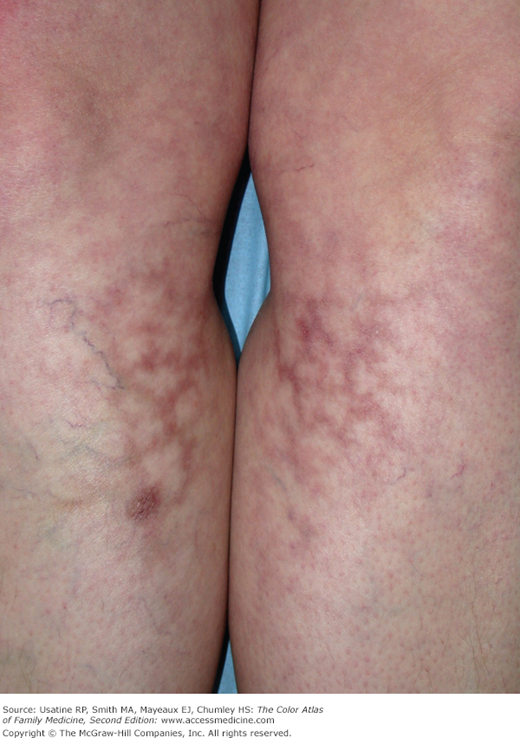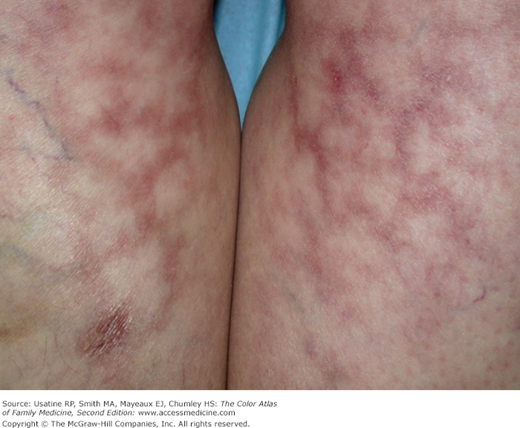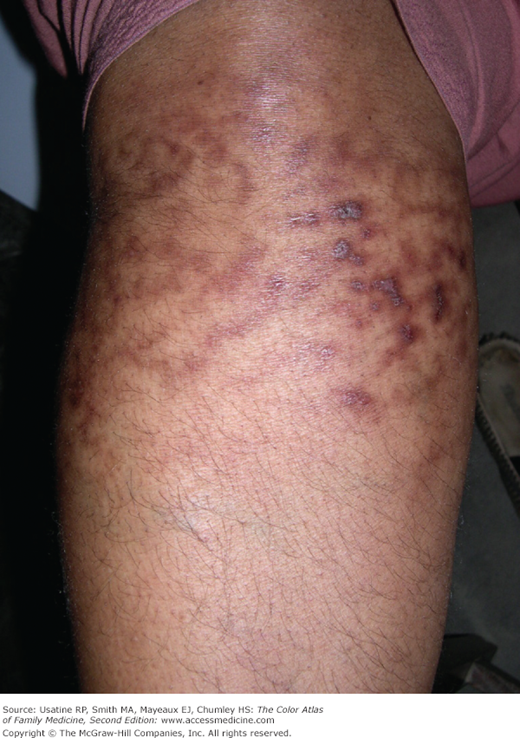Patient Story
A 50-year-old woman presented to the office with bilateral erythematous lesions on the inner aspects of both of her lower extremities (Figures 200-1 and 200-2). The lesions started developing for the past 6 months. They became progressively more noticeable but stayed localized in the inner aspects of the lower extremities. She mentioned that she was using a hot-water bottle in the area involved to keep her warm at night when she was sleeping in bed. Although our working clinical diagnosis was erythema ab igne, clinical entities such as livedo reticularis, poikiloderma atrophicans vasculare, and acanthosis nigricans were also considered in the differential diagnosis. A skin biopsy was performed and confirmed the diagnosis of erythema ab igne. The patient was advised to abandon the hot-water bottle application to the skin. Over the course of 4 months her skin lesions started to clear with no further intervention.
Figure 200-1
Mottled or mesh-like pigmentary changes on the legs of a 50-year-old woman who slept with a hot-water bottle between her legs. (From El-Ghandour A, Selim A, Khachemoune A. Bilateral lesions on the legs. J Fam Pract. 2007;56(1):37-39. Reproduced with permission from Frontline Medical Communications.)
Figure 200-2
Close-up of legs in Figure 200-1. (From El-Ghandour A, Selim A, Khachemoune A. Bilateral lesions on the legs. J Fam Pract. 2007;56(1):37-39. Reproduced with permission from Frontline Medical Communications.)
Introduction
Erythema ab igne is a rare condition caused by chronic exposure to heat (below the threshold for a thermal burn) from external heat sources. More specifically, prolonged use of hot-water bottles, heating pads, electric blankets, car seat warmers as well as exposure to open fires and laptops placed on the users’ thighs or propped legs have all been reported to cause erythema ab igne. Affected skin is characterized by reticular pink colored and hyperpigmented mottled patches. Patients may complain of associated pruritus, paresthesias, or may be asymptomatic. Treatment is limited and patients are instructed to avoid triggers.
Synonyms
Epidemiology
Etiology and Pathophysiology
- The skin findings form as a result of multiple exposures to an intense source of heat.
- Erythema ab igne has been noted for many years, and the sources of heat have changed over time. It used to be reported in women who stay for long periods of time in front of open fires, fireplaces, or furnaces to cook.1–4 Most of the lesions were appearing on the medial side of the thigh and the lower leg in general.
- Currently, erythema ab igne is seen on different parts of the body, depending on what source of heat initiated the pathology, the angle of the heat radiation, the morphology of the skin, and the layers of clothing. Some of the modern-day examples are repeated application of hot-water bottles or heating pads to treat chronic pain, exposure to car heaters and furniture with internal heaters, the use of a laptop computer for long periods, and cooks and chefs who stand for long periods in the range of heat. Other causes include hot bricks, infrared lamps, and even microwave popcorn. Ultrasound physiotherapy was also reported as a cause of erythema ab igne. Recently, there was a reported case of frequent prolonged hot baths that caused the disease.5
Risk Factors
- Persistent exposure to heat.
- Occupations that involve chronic exposure to external heat sources (e.g., kitchen workers, silversmiths, jewelers, foundry workers).6
Diagnosis
- Some patients have mild pruritus or burning sensation, but the majority of patients are asymptomatic.
- Skin lesions may not appear immediately after the exposure; it might take a period of 1 month to show up. Skin changes start as a reddish-brown pigmentation distributed as a mottled rash and are followed by skin atrophy (Figures 200-1, 200-2, and 200-3).
- Telangiectasias with diffuse hyperpigmentation and subepidermal bullae may also develop.
- The rash appears mesh-like or net-like in the area exposed to the heat. The heat can be from fireplaces, heating pads, laptop computers, open fires, place heaters, and hot-water bottles (Figures 200-1, 200-2, 200-3, 200-4, 200-5, 200-6, and 200-7).
- Malignant melanoma and various sarcomas are reported to arise in burn scars; however, those arising in areas of erythema ab igne have not been reported to date.
Stay updated, free articles. Join our Telegram channel

Full access? Get Clinical Tree





